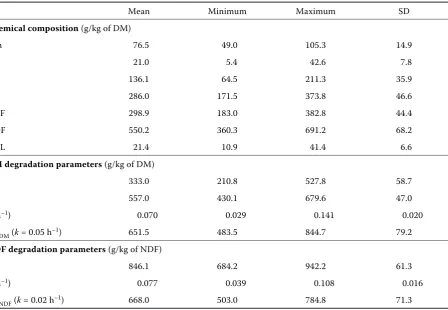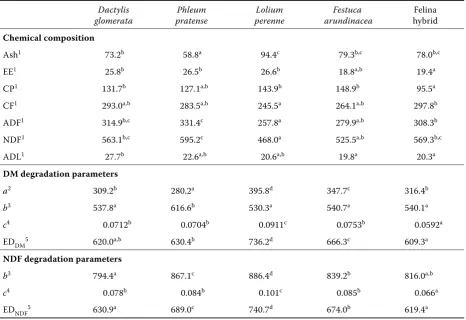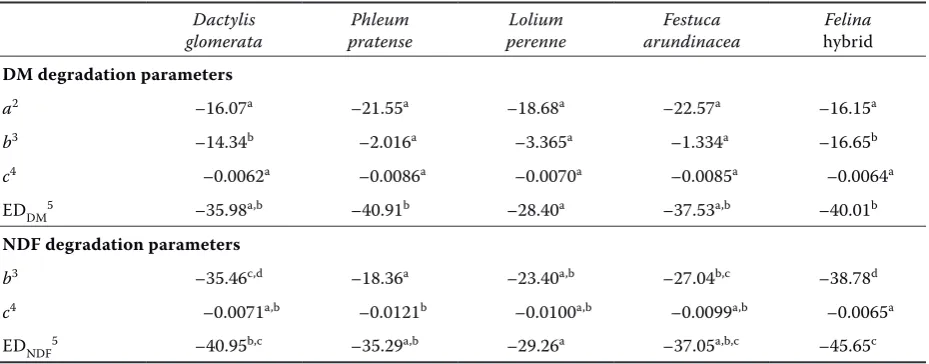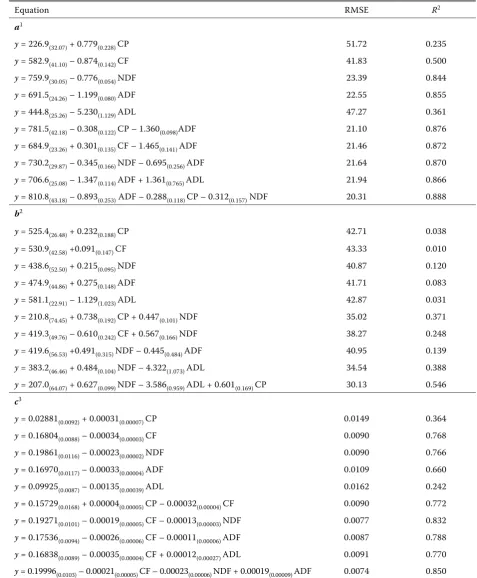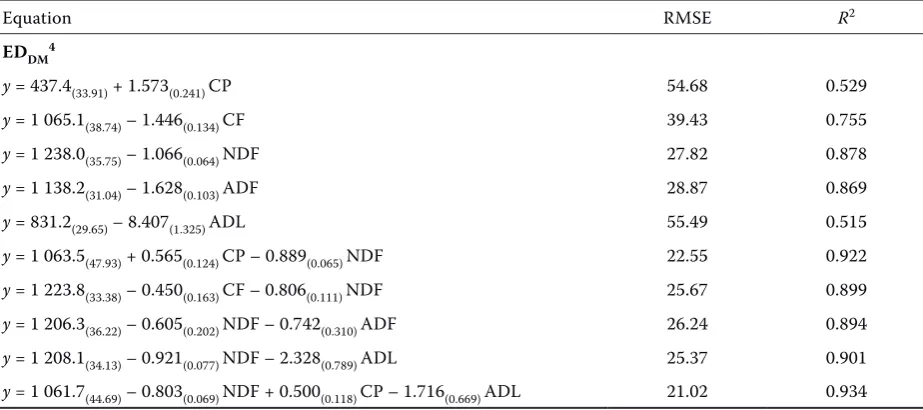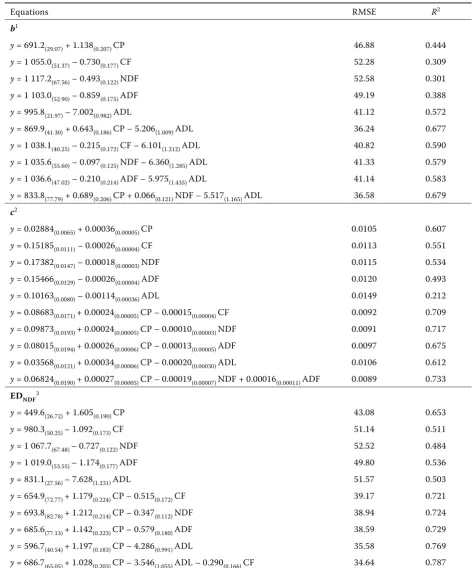Forage production in the Czech Republic and Central Europe is dominated by grasses. However, there is a lack of information about ruminal degrad-ability of dry matter (DM) and neutral detergent fibre (NDF) of the most important grass species grown in European countries. The rate and extent of DM fermentation in the rumen are crucial de-terminants of the nutrients utilized by ruminants (Kamalak et al., 2005). The main factor influencing the rate of fermentation of feeds is the structure of the carbohydrate fraction, especially the extent of lignification of the cell wall (Nagadi et al., 2000).
Rumen degradability is routinely determined by
use of the in sacco method. This method is used for
measuring of degradation parameters of a whole
spectrum of nutrients and feeds (Čerešňáková et al., 2007; Homolka et al., 2007, 2008). However, the
in sacco method requires rumen-cannulated ani-mals, and is time consuming and expensive. These have resulted in a search for alternative methods
to evaluate rumen digestibility. In vitro methods,
such as gas production (Pozdíšek and Vaculová, 2008; Jalč et al., 2009), pepsin-cellulase solubility (Nousiainen et al., 2003a,b) and others (Cherney et al., 1993; López et al., 1998; Koukolová et al., 2004), are hampered by a need for rumen fluid from experimental animals, expensive chemicals and commercial enzymes. Other options to esti-mate digestibility are through prediction equations based on chemical composition. These prediction
Supported by the Ministry of Agriculture of the Czech Republic (Project MZE No. 0002701404).
Ruminal degradability of dry matter and neutral
detergent fibre of grasses
F. Jančík, V. Koukolová, P. Homolka
Institute of Animal Science, Prague-Uhříněves, Czech Republic
ABSTRACT: A study was conducted (I) to determine rumen degradability (in sacco) of dry matter (DM) and neutral detergent fibre (NDF) of the most important grass species grown in the Czech Republic, (II) to
compare grass species (n = 5) according to calculated degradation parameters, and (III) to establish
predic-tion equapredic-tions for degradapredic-tion parameters from chemical composipredic-tion. Forty samples of the most important grass species (Dactylis glomerata, Phleum pratense, Lolium perenne, Festuca arundinacea, Felina hybrid) were
harvested in 2004 and 2005 and analyzed for chemical composition, and DM and NDF in sacco degradability.
Results from the in sacco method were used to calculate DM and NDF degradation parameters. Linear and
stepwise multiple regression analyses were used to develop prediction equations for DM and NDF degra-dation parameters from nutrient concentrations. The highest DM and NDF degradegra-dation parameters were
found for Lolium perenne. DM and NDF rumen degradation parameters were successfully predicted from
chemical composition, with a single predictor adequate for most parameters. For all parameters R2-values
increased with addition of more predictors into regression equations. Effective degradability (ED) of DM cal-culated at a rumen outflow rate (k) of 0.05 h–1 was the best predicted by NDF (R2 = 0.878), and ED of NDF at k = 0.02 h–1 by crude protein (CP) (R2 = 0.653).
equations are an appropriate for institutions that
lack experimental animals and equipment for in
vitro digestibility analysis (Jančík et al., 2008). Prediction equations based on chemical composi-tion have been successfully applied for different feeds and nutrients (Nousiainen et al., 2003a; Yan and Agnew, 2004; Andrés et al., 2005; Jančík et al., 2009; Villamide et al., 2009). However, adequate equations to predict DM and NDF rumen degrada-tion parameters of grasses from chemical composi-tion are lacking.
This study aimed (I) to determine rumen de-gradability of DM and NDF of the most important grass species grown in the Czech Republic, (II) to
compare grass species (n = 5) according to
calcu-lated degradation parameters, and (III) to compute prediction equations for degradation parameters from chemical composition. These would add to the present knowledge of DM and NDF rumen di-gestion kinetics of grass species commonly grown in the Czech Republic.
MATERIAL AND METHODS
Samples
Forty samples of five of the most frequently used grass species for ruminant nutrition in the Czech
Republic (Dactylis glomerata L. – variety Dana,
Phleum pratense L. – Sobol variety, Lolium perenne
L. – Jaspis variety, Festuca arundinacea L. – Prolate
variety and Felina hybrid) were evaluated. Grasses were grown as a monoculture at the Větrov Breeding Station, Tábor region, Czech Republic (49°31’2.04” N lat, 14°28’4.9” E long; 620 m altitude). They were harvested from primary growth at six dates in 2004 (May 13th; May 19th; May 26th; June 2nd; June 9th;
June 16th) and at two dates in 2005 (May 20th; June
3rd). The samples were oven-dried at 50°C for 48 h
and milled through a 1 mm screen.
Chemical analysis
All samples (n = 40) were analyzed for DM, crude
protein (CP), ash, ether extract (EE), NDF, acid detergent fibre (ADF) and acid detergent lignin (ADL). DM was determined at 105°C for 12 h of oven-drying, and ash content after combusting at 550°C for 4.5 h (Regulation No. 497/2004, 2004). EE was extracted for 6 h with petroleum-ether.
The Kjeldahl method was used for determination of nitrogen (N) (AOAC Official Method 976.05; AOAC, 2005), with content of CP calculated as N × 6.25. NDF was determined according to the methods of Van Soest et al. (1991), and ADF and ADL according to AOAC Official Method 973.18 (AOAC, 2005) adapted for an ANKOM 220 Fibre Analyzer (ANKOM Technology Corporation, NY, USA).
In sacco procedure
Ruminal DM and NDF disappearances were
es-timated by the in sacco technique. Grass samples
were incubated (three bags per sample per incuba-tion time) in the rumen of two Holstein cows fit-ted with permanent rumen fistula. Rations of the fistulated cows consisted of ad lib meadow hay sup-plemented with 1 kg of barley meal per day and animal. Samples were weighed (1.5 g; 1 mm screen sieve) into nylon bags with a pore size of 42 µm (internal dimensions 50 × 120 mm) (Uhelon 130 T, Silk and Progress Moravská Chrastová). The nylon bags with the weighed samples were attached to a cylindrical carrier and incubated in the rumen for 6, 12, 24, 48, 72 and 96 h. Upon removal, bags were hand washed in cold water for 30 minutes. Zero time disappearances were obtained from washed nylon bags not subjected to rumen incubation. All washed nylon bags were dried in a forced-air oven at 50°C for 48 h.
The rumen degradation parameters of DM and NDF were calculated using the equations of Ørskov and McDonald (1979):
Deg DM(t) = a + b × (1 – exp–ct)
Deg NDF(t) = b × (1 – exp–ct)
where:
Deg (t) = disappearance of DM or NDF at time t
a = intercept representing the portion of DM solubilized at the initiation of incubation (time 0)
b = fraction of DM or NDF potentially degradable in the rumen
c = rate constant of disappearance of fraction b t = time of incubation
The effective ruminal degradability of DM (EDDM)
and NDF (EDNDF) were calculated according to
EDDM = a + b × (c/(c + k)) EDNDF = b × (c/(c + k))
where:
k = ruminal outflow rate, being k = 0.05 h–1 for ED
DM
(Ramí-rez et al., 2009)
k = 0.02 h–1 for ED
NDF (Koukolová et al., 2004)
Statistical analysis
The MIXED procedure of SAS (SAS, 2002–2003) was used to evaluate the influence of harvest dates and grass species on chemical composition, and DM and NDF degradation parameters. The effects of year and grass species were considered as fixed, and harvest date was nested in each level of the fac-tor grass as a covariate. Because of heterogeneity of the variance the different variances for harvest dates were taken into account in the
variance-co-variance structure of the model. Changes in the chemical composition, and DM and NDF degrada-tion parameters, at consecutive harvest dates were evaluated with Scheffe’s pairwise comparison, ad-justed with the Bonferroni correction to control the overall type I error rate (Rasch et al., 1999).
Linear and stepwise multiple regression analyses (Statistica 6, 2001) were used to develop prediction equations for DM and NDF degradation parameters from nutrient concentrations in grasses.
RESULTS AND DISCUSSION
Chemical composition and degradation para-meters of DM and NDF of grass samples are pre-sented in Table 1. Chemical composition showed wide variation among grasses. Values ranged with 146.8 for CP, 199.8 for ADF, 330.9 for NDF and 30.5 g/kg for ADL between minimum and
maxi-Table 1. Chemical composition and degradation parameters of grass samples (n = 40)
Mean Minimum Maximum SD
Chemical composition (g/kg of DM)
Ash 76.5 49.0 105.3 14.9
EE 21.0 5.4 42.6 7.8
CP 136.1 64.5 211.3 35.9
CF 286.0 171.5 373.8 46.6
ADF 298.9 183.0 382.8 44.4
NDF 550.2 360.3 691.2 68.2
ADL 21.4 10.9 41.4 6.6
DM degradation parameters (g/kg of DM)
a 333.0 210.8 527.8 58.7
b 557.0 430.1 679.6 47.0
c (h–1) 0.070 0.029 0.141 0.020
EDDM (k = 0.05 h–1) 651.5 483.5 844.7 79.2
NDF degradation parameters (g/kg of NDF)
b 846.1 684.2 942.2 61.3
c (h–1) 0.077 0.039 0.108 0.016
EDNDF (k = 0.02 h–1) 668.0 503.0 784.8 71.3
mum. Comparable results were reported by Cherney
et al. (1993) for Phleum pratense and Festuca
arund-inacea, López et al. (1998) for grass hay, Jensen et al.
(2003) for Dactylis glomerata and Lolium perenne
and Sommer et al. (2005) for meadow hay.
Similarly, DM degradation parameters showed large differences between the lowest and highest val-ues, with differences of 317 g/kg of DM, 249.5 g/kg of DM, 0.112 h–1 and 361.2 g/kg of DM for a, b, c
and ED, respectively. Yu et al. (2004) found that
a varied from 169 to 213 g/kg of DM, b from 431
to 577 g/kg of DM, c from 0.026 to 0.059 h–1, and
EDDM from 609 to 698 g/kg of DM in Phleum
prat-ense. EDDM values of 470 and 560 g/kg DM were
re-ported for meadow hay (Rymer and Givens, 2002) and Festuca arundinacea (Elizalde et al., 1999),
respectively. With different forages, Coblentz et al. (1998) stated values of 189 to 268 g/kg of DM,
of NDF, respectively, between minimum and maxi-mum values. A range of 595 to 752 g/kg of NDF
for b and 0.032 to 0.056 h–1 for c were reported
for Tripsacum dactyloides (Coblentz et al., 1998).
Lolium multiflorum was characterized by a b
value of 598 g/kg NDF and c value of 0.0291 h–1
(Andrighetto et al., 1993).
Table 2. Comparison of chemical composition, dry matter (DM) and neutral detergent fibre (NDF) rumen degra-dation parameters of grass species
Dactylis
1portion of dry matter solubilized at the initiation of incubation (time 0), (g/kg of DM)
2fraction of dry matter (g/kg of DM) or neutral detergent fibre (g/kg of NDF) potentially degradable in the rumen 3rate constant of disappearance of fraction b (h–1)
4effective ruminal degradability of dry matter (ED
DM) (g/kg of DM) and neutral detergent fibre (EDNDF) (g/kg of NDF)
calculated with ruminal solid outflow rate (k) 0.05 h–1 (ED
Table 2 shows mean values for chemical compo-sition, and DM and NDF degradation parameters
of the evaluated grass species. Festuca arundinacea
contained the highest CP and lowest EE and ADL contents. On the contrary, the lowest CP content was found for the Felina hybrid. This grass showed
the highest CF content. Dactylis glomerata
present-ed the highest content of ADL. The lowest content of ash and the highest contents of ADF and NDF
were detected in Phleum pratense. In contrast, the
highest contents of ash and EE and the lowest
con-tents of CF, ADF and NDF were found in Lolium
perenne. In agreement to present results, Skládanka et al. (2008) detected higher NDF and lower ADF
contents in the Felina hybrid compared to Dactylis
glomerata. However, in contrast to our results, Skládanka et al. (2008) showed better quality (ac-cording to chemical composition) for the Felina
hybrid than for Festuca arundinacea.
The highest sum of DM soluble (parameter a)
and degradable (parameter b) components was
calculated for Lolium perenne (926.1 g/kg DM).
This grass also presented the highest values for c
and EDDM. Dactylis glomerata showed the lowest
sum of DM soluble and degradable components (a + b), with the lowest c and EDDM values found
in the Felina hybrid (Table 2). Wilman and Ahmad (1999) show a similar tendency for organic matter
digestibility of Lolium perenne when compared to
Festuca arundinacea.
NDF rumen degradation parameters (Table 2) were in agreement to DM rumen degradation
pa-rameters in the order of quality: Lolium perenne,
Phleum pratense, Festuca arundinacea, Felina
hy-brid and Dactylis glomerata. Higher NDF
digest-ibility of Festuca arundinacea in comparison with
a grass hybrid (Hykor) was described by Pozdíšek et al. (2003).
Changes in DM and NDF rumen degradation pa-rameters at harvest dates calculated for each of the grass species are presented in Table 3. The values describe a decrease in degradation parameters dur-ing 7 days of maturdur-ing (time between neighbour-ing harvests). The ruminal degradation parameters of observed grass species decreased linearly with
increasing date of harvest. Dactylis glomerata had
the lowest changes in DM degradation for the
pa-rameters a and c in comparison with the other grass
species. Festuca arundinacea presented the
low-est changes in the potential degradable component
of DM (parameter b). For both EDDM and EDNDF
the lowest changes were determined for Lolium
Table 3. Changes in dry matter (DM) and neutral detergent fibre (NDF) ruminal degradation parameters of grass species in relation to maturity (different dates of harvest)1
Dactylis
1values show how much parameters decreased during 7 days (between neighbouring harvests) of maturation 2portion of dry matter solubilized at the initiation of incubation (time 0), (g/kg of DM)
3fraction of dry matter (g/kg of DM) or neutral detergent fibre (g/kg of NDF) potentially degradable in the rumen 4rate constant of disappearance of fraction b (h–1)
5effective ruminal degradability of dry matter (ED
DM) (g/kg of DM) and neutral detergent fibre (EDNDF) (g/kg of NDF)
calculated with ruminal solid outflow rate (k) 0.05 h–1 (ED
Table 4. Prediction equations of grass dry matter (DM) degradation parameters, units are in g/kg of DM; the data subscripted within parentheses are standard error values
Equation RMSE R2
a1
y = 226.9(32.07) + 0.779(0.228) CP 51.72 0.235
y = 582.9(41.10) – 0.874(0.142) CF 41.83 0.500
y = 759.9(30.05) – 0.776(0.054) NDF 23.39 0.844
y = 691.5(24.26) – 1.199(0.080) ADF 22.55 0.855
y = 444.8(25.26) – 5.230(1.129) ADL 47.27 0.361
y = 781.5(42.18) – 0.308(0.122) CP – 1.360(0.098)ADF 21.10 0.876
y = 684.9(23.26) + 0.301(0.135) CF – 1.465(0.141) ADF 21.46 0.872
y = 730.2(29.87) – 0.345(0.166) NDF – 0.695(0.256) ADF 21.64 0.870
y = 706.6(25.08) – 1.347(0.114) ADF + 1.361(0.765) ADL 21.94 0.866
y = 810.8(43.18) – 0.893(0.253) ADF – 0.288(0.118) CP – 0.312(0.157) NDF 20.31 0.888
b2
y = 525.4(26.48) + 0.232(0.188) CP 42.71 0.038
y = 530.9(42.58) +0.091(0.147) CF 43.33 0.010
y = 438.6(52.50) + 0.215(0.095) NDF 40.87 0.120
y = 474.9(44.86) + 0.275(0.148) ADF 41.71 0.083
y = 581.1(22.91) – 1.129(1.023) ADL 42.87 0.031
y = 210.8(74.45) + 0.738(0.192) CP + 0.447(0.101) NDF 35.02 0.371
y = 419.3(49.76) – 0.610(0.242) CF + 0.567(0.166) NDF 38.27 0.248
y = 419.6(56.53) +0.491(0.315) NDF – 0.445(0.484) ADF 40.95 0.139
y = 383.2(46.46) + 0.484(0.104) NDF – 4.322(1.073) ADL 34.54 0.388
y = 207.0(64.07) + 0.627(0.099) NDF – 3.586(0.959) ADL + 0.601(0.169) CP 30.13 0.546
c3
y = 0.02881(0.0092) + 0.00031(0.00007) CP 0.0149 0.364
y = 0.16804(0.0088) – 0.00034(0.00003) CF 0.0090 0.768
y = 0.19861(0.0116) – 0.00023(0.00002) NDF 0.0090 0.766
y = 0.16970(0.0117) – 0.00033(0.00004) ADF 0.0109 0.660
y = 0.09925(0.0087) – 0.00135(0.00039) ADL 0.0162 0.242
y = 0.15729(0.0168) + 0.00004(0.00005) CP – 0.00032(0.00004) CF 0.0090 0.772
y = 0.19271(0.0101) – 0.00019(0.00005) CF – 0.00013(0.00003) NDF 0.0077 0.832
y = 0.17536(0.0094) – 0.00026(0.00006) CF – 0.00011(0.00006) ADF 0.0087 0.788
y = 0.16838(0.0089) – 0.00035(0.00004) CF + 0.00012(0.00027) ADL 0.0091 0.770
y = 0.19996(0.0103) – 0.00021(0.00005) CF – 0.00023(0.00006) NDF + 0.00019(0.00009) ADF 0.0074 0.850
perenne. Phleum pratense and the Felina hybrid
showed the lowest changes for b and c of the NDF
fraction, respectively.
Differences among grass species might be relat-ed to differences in maturing of observrelat-ed grasses.
Equation RMSE R2
1portion of dry matter solubilized at the initiation of incubation (time 0), (g/kg of DM) 2fraction of dry matter potentially degradable in the rumen (g/kg of DM)
3rate constant of disappearance of fraction b (h–1) 4effective ruminal degradability of dry matter (ED
DM) (g/kg of DM) calculated with ruminal solid outflow rate (k) 0.05 h–1
(EDDM)
RMSE = residual mean square error; R2 = coefficient of determination Table 4 to be continued
maturing grass species, whereas Lolium perenne,
Festuca arundinacea and Phleum pratense are late maturing grasses.
Regression equations that describe the relation-ships between DM rumen degradation parameters and the chemical composition of grasses are
pre-sented in Table 4. According to R2-values and
resid-ual mean square errors, ADF (R2 = 0.855) and NDF
(R2 = 0.844) were found as the best single predictors
of parameter a. Parameter b was the best predicted
by NDF (R2 = 0.120). However, a single predictor
was non-significant for this parameter. A regression
with three predictors (NDF, ADL, CP) presented a R2
value of 0.546. Parameter c was adequately predicted
using CF (R2 = 0.768) or NDF (R2 = 0.766). EDDM
was best predicted by NDF (R2 = 0.878), although all
presented equations gave satisfactory predictions.
NDF was also detected as the best EDDM predictor
for grass silages by Jančík et al. (2009). Nousiainen et al. (2003a) found ADF as the best single predictor of organic matter digestibility of grass silages.
Table 5 indicates the regression equations that described the relationships between NDF rumen degradation parameters and chemical
composi-tion of evaluated grasses. Parameter b was the best
predicted by ADL (R2 = 0.572), whereas NDF
pre-sented a R2 value as low as 0.301. The combination
of CP and ADL predicted the parameter b with a
R2 value of 0.677. The best predictor of parameter
c was CP (R2 = 0.607). ADL has the lowest value
(R2 = 0.212) to predict c. EDNDF was best predicted
by CP (R2 = 0.653). NDF was found as inadequate
(R2 = 0.484) to describe this parameter. According
to linear multiple regression the combination of
CP and ADL was superior (R2 = 0.769) to predict
EDNDF. This combination was found by Jančík et al.
(2008) as adequate for prediction of the inible part of NDF, and for organic matter digest-ibility of regrowth grass silages by Nousiainen et al. (2003b). Use of a higher number of predictors
yielded equations with higher R2-values and lower
residual mean square errors.
Table 5. Prediction equations of grass neutral detergent fibre (NDF) degradation parameters; the data subscripted within parentheses are standard error values
Equations RMSE R2
b1
y = 691.2(29.07) + 1.138(0.207) CP 46.88 0.444
y = 1 055.0(51.37) – 0.730(0.177) CF 52.28 0.309
y = 1 117.2(67.56) – 0.493(0.122) NDF 52.58 0.301
y = 1 103.0(52.90) – 0.859(0.175) ADF 49.19 0.388
y = 995.8(21.97) – 7.002(0.982) ADL 41.12 0.572
y = 869.9(41.30) + 0.643(0.186) CP – 5.206(1.009) ADL 36.24 0.677
y = 1 038.1(40.25) – 0.215(0.172) CF – 6.101(1.212) ADL 40.82 0.590
y = 1 035.6(55.60) – 0.097(0.125) NDF – 6.360(1.285) ADL 41.33 0.579
y = 1 036.6(47.02) – 0.210(0.214) ADF – 5.975(1.435) ADL 41.14 0.583
y = 833.8(77.79) + 0.689(0.206) CP + 0.066(0.121) NDF – 5.517(1.165) ADL 36.58 0.679
c2
y = 0.02884(0.0065) + 0.00036(0.00005) CP 0.0105 0.607
y = 0.15185(0.0111) – 0.00026(0.00004) CF 0.0113 0.551
y = 0.17382(0.0147) – 0.00018(0.00003) NDF 0.0115 0.534
y = 0.15466(0.0129) – 0.00026(0.00004) ADF 0.0120 0.493
y = 0.10163(0.0080) – 0.00114(0.00036) ADL 0.0149 0.212
y = 0.08683(0.0171) + 0.00024(0.00005) CP – 0.00015(0.00004) CF 0.0092 0.709
y = 0.09873(0.0193) + 0.00024(0.00005) CP – 0.00010(0.00003) NDF 0.0091 0.717
y = 0.08015(0.0194) + 0.00026(0.00006) CP – 0.00013(0.00005) ADF 0.0097 0.675
y = 0.03568(0.0121) + 0.00034(0.00006) CP – 0.00020(0.00030) ADL 0.0106 0.612
y = 0.06824(0.0190) + 0.00027(0.00005) CP – 0.00019(0.00007) NDF + 0.00016(0.00011) ADF 0.0089 0.733
EDNDF3
y = 449.6(26.72) + 1.605(0.190) CP 43.08 0.653
y = 980.3(50.25) – 1.092(0.173) CF 51.14 0.511
y = 1 067.7(67.48) – 0.727(0.122) NDF 52.52 0.484
y = 1 019.0(53.55) – 1.174(0.177) ADF 49.80 0.536
y = 831.1(27.56) – 7.628(1.231) ADL 51.57 0.503
y = 654.9(72.77) + 1.179(0.224) CP – 0.515(0.172) CF 39.17 0.721
y = 693.8(82.78) + 1.212(0.214) CP – 0.347(0.112) NDF 38.94 0.724
y = 685.6(77.13) + 1.142(0.223) CP – 0.579(0.180) ADF 38.59 0.729
y = 596.7(40.54) + 1.197(0.183) CP – 4.286(0.991) ADL 35.58 0.769
y = 686.7(65.05) + 1.028(0.203) CP – 3.546(1.055) ADL – 0.290(0.166) CF 34.64 0.787
1fraction of neutral detergent fibre (g/kg of NDF) potentially degradable in the rumen 2rate constant of disappearance of fraction b (h–1)
3effective ruminal degradability of neutral detergent fibre (ED
NDF) (g/kg of NDF) calculated with ruminal solid outflow rate
(k) 0.02 h–1 (ED NDF)
Table 6. Prediction equations of grass dry matter DM degradation parameters calculated for each species, units are in (g/kg of DM); the data subscripted within parentheses are standard error values
Grass Equation RMSE R2
a1
Dactylis g.
y = 576.8(32.94) – 0.843(0.104) ADF 10.68 0.917
y = 509.4(71.35) – 1.387(0.524) ADF + 0.420(0.396) NDF 10.57 0.932
Phleum p.
y = 661.6(46.48) – 1.140(0.139) ADF 13.29 0.918
y = 791.9(74.85) – 1.411(0.176) ADF – 0.300(0.149) CP 10.82 0.955
Lolium p.
y = 710(92.89) – 1.205(0.356) ADF 36.06 0.656
y = 746.9(103.3) – 1.840(0.802) ADF + 6.421(7.225) ADL 36.71 0.703
Festuca a.
y = 658(32.47) – 1.093(0.115) ADF 13.27 0.938
y = 850.4(77.77) – 1.468(0.166) ADF – 0.562(0.217) CP 9.49 0.974
Hybrid y = 598.8(79.80) – 0.904(0.257) ADF 23.01 0.673
y = 554(46.57) – 1.741(0.267) ADF + 0.988(0.265) CF 12.97 0.913
b2
Dactylis g. y = 686.7(124.2) – 0.252(0.217) NDF 29.59 0.183
y = 299.8(177.7) + 1.130(0.447) CP + 0.153(0.225) NDF 21.48 0.641
Phleum p.
y = 525.1(66.64) + 0.152(0.110) NDF 17.88 0.241
y = 322.3(47.58) + 0.382(0.064) NDF + 0.486(0.091) CP 7.60 0.886
Lolium p.
y = 360.3(90.68) + 0.688(0.352) CF 37.87 0.389
y = 313.6(103.5) + 0.491(0.512) CP + 0.582(0.371) CF 38.13 0.484
Festuca a.
y = 522.8(40.75) + 0.075(0.146) CF 22.49 0.042
y = 325(202) + 0.657(0.657) CP + 0.425(0.379) CF 22.49 0.201
Hybrid y = 616.3(32.76) – 3.610(1.595) ADL 29.55 0.461
y = 488.1(192.7) + 0.575(0.851) ADF – 6.147(4.109) ADL 30.99 0.506
c3
Dactylis g. y = 0.225(0.023) – 0.00028(0.00004) NDF 0.005 0.889
y = 0.266(0.022) – 0.00038(0.00005) NDF + 0.00071(0.00027) ADL 0.004 0.954
Phleum p.
y = 0.218(0.022) – 0.00025(0.00004) NDF 0.006 0.889
y = 0.202(0.023) – 0.00015(0.00008) NDF – 0.00015(0.00011) CF 0.005 0.921
Lolium p.
y = 0.236(0.024) – 0.00031(0.00005) NDF 0.008 0.868
y = 0.235(0.021) – 0.00018(0.0001) NDF – 0.00025(0.00016) ADF 0.007 0.910
Festuca a.
y = 0.135(0.014) – 0.00023(0.00005) CF 0.008 0.788
y = 0.107(0.018) – 0.00047(0.00013) CF + 0.00033(0.00017) ADF 0.006 0.883
Hybrid y = 0.015(0.0046) + 0.00041(0.00004) CP 0.003 0.937
y = 0.075(0.024) + 0.00026(0.00007) CP – 0.00015(0.00006) CF 0.002 0.972
equations based on CF could be used when de-tergent analyses are not available. ADF does not represent all the insoluble fibre, but it is usually
Grass Equation RMSE R2
1portion of dry matter solubilized at the initiation of incubation (time 0), (g/kg of DM) 2fraction of dry matter potentially degradable in the rumen (g/kg of DM)
3rate constant of disappearance of fraction b (h–1) 4effective ruminal degradability of dry matter (ED
DM) (g/kg of DM) calculated with ruminal solid outflow rate (k) 0.05 h–1
(EDDM)
RMSE = residual mean square error; R2 = coefficient of determination Table 6 to be continued
all feed components. Non-cell wall components are not influenced by lignin, but they often can be highly correlated. As a result of encrustation, lignin affects mainly availability of cell wall polysac-charides (Van Soest, 1994). It was evident in the presented prediction equations of the NDF
degra-dation parameter b, where ADL was detected as
the best single predictor. Although parameter c
of NDF degradation was the best predicted by CP, the chemical components CF, NDF and ADF as sole predictors presented near similar values for re-gression coefficients. A similar tendency obtained
with EDNDF was caused by the profound influence
of parameter c in the calculation of EDNDF. A high
correlation between CP and parameter c most likely
occurred because of coassociation, when protein declines as grass matures and lignification proceeds (Van Soest, 1994; Nousiainen et al., 2003a).
Equations to predict DM and NDF degradation parameters from chemical composition for indi-vidual grass species are presented Tables 6 and 7, respectively. The best single predictor equation and equations with the best combination of two predic-tors are shown. Equations mostly correspond to equations presented in Tables 4 and 5. However,
equations calculated for each species were more
accurate (higher R2 and lower RMSE) compared
to equations that included data from all grasses. This could probably related to a low number of
grass samples (n = 8).
CONCLUSIONS
This study showed that Lolium perenne
pre-sented the highest DM and NDF rumen degra-dation parameters of all evaluated grass species. Furthermore, the study confirmed that DM and NDF rumen degradation parameters in grass spe-cies can be predicted from chemical composition with satisfactory accuracy. A single predictor was adequate to predict most of the degradation pa-rameters. However, with combinations of chemi-cal components used as predictors the accuracy of prediction equations will improve. It could be recommended that all prediction equations with
R2 > 0.500 can be applied in practice. For prediction
of the DM degradation parameters a, c and EDDM,
the use of single prediction equation based on NDF
Table 7. Prediction equations of grass neutral detergent fibre (NDF) degradation parameters for each species; the data subscripted within parentheses are standard error values
Grass Equations RMSE R2
b1
Dactylis g.
y = 976.8(26.22) – 6.488(0.927) ADL 23.04 0.891
y = 1 021.3(63.35) – 0.207(0.266) CF – 5.818(1.289) ADL 23.84 0.903
Phleum p.
y = 989.8(15.93) – 5.470(0.707) ADL 11.67 0.909
y = 921.9(37.97) – 4.008(0.967) ADL + 0.269(0.141) CP 9.72 0.947
Lolium p.
y = 659(44.62) + 1.488(0.292) CP 22.76 0.813
y = 619.2(62.61) + 1.403(0.310) CP + 0.207(0.225) CF 23.06 0.840
Festuca a.
y = 1 193.4(81.99) – 1.227(0.289) ADF 33.50 0.750
y = 1 256.8(93.95) – 2.233(0.862) ADF + 0.800(0.649) CF 32.13 0.808
Hybrid y = 1 010.7(23.27) – 9.548(1.133) ADL 21.00 0.922
y = 896.8(133.3) + 0.512(0.589) ADF – 11.80(2.843) ADL 21.44 0.932
c2
Dactylis g. y = 0.244(0.017) – 0.00030(0.00003) NDF 0.004 0.941
y = 0.265(0.028) – 0.00044(0.00015) NDF + 0.00020(0.0002) ADF 0.004 0.950
Phleum p.
y = 0.179(0.016) – 0.00035(0.00006) CF 0.007 0.869
y = 0.200(0.028) – 0.00024(0.00013) CF – 0.00009(0.00010) NDF 0.007 0.888
Lolium p.
y = 0.052(0.013) + 0.00026(0.00009) CP 0.007 0.620
y = 0.067(0.022) + 0.00024(0.00009) CP – 0.00056(0.00064) ADL 0.007 0.671
Festuca a.
y = 0.136(0.013) – 0.00021(0.00005) CF 0.007 0.769
y = 0.113(0.013) – 0.00030(0.00005) CF + 0.00245(0.00098) ADL 0.005 0.897
Hybrid y = 0.018(0.009) + 0.00043(0.00009) CP 0.007 0.803
y = –0.011(0.024) + 0.00057(0.00014) CP + 0.00075(0.00057) ADL 0.006 0.854
EDNDF3
Dactylis g. y = 828.2(29.41) – 7.239(1.04) ADL 25.84 0.890
y = 950.4(44.71) – 0.568(0.188) CF – 5.402(0.909) ADL 16.82 0.961
Phleum p.
y = 1 188.2(49.43) – 1.509(0.148) ADF 9.516 0.979
y = 1 155.5(35.17) – 0.987(0.207) ADF – 0.480(0.167) CF 9.520 0.979
Lolium p.
y = 487.1(44.33) + 1.580(0.290) CP 22.62 0.832
y = 446.3(61.86) + 1.493(0.306) CP + 0.212(0.222) CF 22.79 0.858
Festuca a.
y = 1 066.1(44.87) – 1.399(0.158) ADF 18.33 0.929
y = 1 153.7(96.68) – 0.866(0.545) ADF – 0.446(0.437) NDF 18.27 0.941
Hybrid y = 1 284.6(89.55) – 2.153(0.289) ADF 25.82 0.903
y = 931.5(227.5) – 1.353(0.546) ADF + 1.038(0.627) CP 22.74 0.937
1fraction of neutral detergent fibre (g/kg of NDF) potentially degradable in the rumen 2rate constant of disappearance of fraction b (h–1)
3effective ruminal degradability of neutral detergent fibre (ED
NDF) (g/kg of NDF) calculated with ruminal solid outflow rate
(k) 0.02 h–1 (ED NDF)
a prediction equation based on a combination of three predictors (NDF, ADL and CP) is needed. With NDF degradation parameters, prediction equations based on two predictors were found to be the most accurate. Presented prediction equations were de-veloped with a large and comprehensive data set, therefore they can be recommended for practical application. However, more research is needed to investigate the relationships between chemical com-position and degradation parameters for dried or ensiled grasses, legumes and other forages.
Acknowledgements
We thank James Sales (Institute of Animal Science, Prague, Czech Republic) for his editorial help with the manuscript.
REFERENCES
Andrighetto I., Bailoni L., Cozzi G., Tolosa H.F., Hartman B., Hinds M., Sapienzs D. (1993): Observations on in situ degradation of forage cell components in alfalfa and Italian ryegrass. Journal of Dairy Science, 76, 2624–2631.
AOAC (2005): Official Methods of Analysis, AOAC In-ternational. 18th ed. Gaithersburg, USA.
Coblentz W.K., Fritz J.O., Fick W.H., Cochran R.C., Shirley J.E. (1998): In situ dry matter, nitrogen, and fiber degradation of alfalfa, red clover, and eastern gamagrass at four maturities. Journal of Dairy Science, 81, 150–161.
Cherney D.J.R., Cherney J.H., Lucey R.F. (1993): In vitro digestion kinetics and quality of perennial grasses as influenced by forage maturity. Journal of Dairy Science, 76, 790–797.
Čerešňáková Z., Fľak P., Poláčiková M., Chrenková M. (2007): In sacco macromineral release from selected for-ages. Czech Journal of Animal Science, 52, 175–182. Elizalde J.C., Merchen N.R., Faulkner D.B. (1999): In situ
dry matter and crude protein degradation of fresh for-ages during the spring growth. Journal of Dairy Science, 82, 1978–1990.
Gosselink J.M.J., Dulphy J.P., Tamminga S., Cone J.W. (2004): Comparison of the in situ technique and the gas production technique in mimicking rumen dry matter degradation. Journal of Animal and Feed Sci-ences, 13, 79–82.
Homolka P., Harazim J., Třináctý J. (2007): Nitrogen de-gradability and intestinal digestibility of rumen
unde-graded protein in rapeseed, rapeseed meal and extracted rapeseed meal. Czech Journal of Animal Science, 52, 378–386.
Homolka P., Koukolová V., Němec Z., Mudřík Z., Hučko B., Sales J. (2008): Amino acid contents and intestinal digestibility of lucerne in ruminants as influenced by growth stage. Czech Journal of Animal Science, 53, 499–505.
Jalč D., Lauková A., Simonová M., Váradyová Z., Homolka P. (2009): The use of bacterial inoculants for grass si-lage: their effects on nutrient composition and fermen-tation parameters in grass silages. Czech Journal of Animal Science, 54, 84–91.
Jančík F., Homolka P., Čermák B., Lád F. (2008): Deter-mination of indigestible neutral detergent fibre con-tents of grasses and its prediction from chemical composition. Czech Journal of Animal Science, 53, 128–135.
Jančík F., Koukolová V., Kubelková P., Čermák B. (2009): Effects of grass species on ruminal degradability of si-lages and prediction of dry matter effective degradabil-ity. Czech Journal of Animal Science, 54, 315–323. Jensen K.B., Waldron B.L., Asay K.H., Johnson D.A.,
Mo-naco T.A. (2003): Forage nutritional characteristics of orchardgrass and perennial ryegrass at five irrigation levels. Agronomy Journal, 95, 668–675.
Kamalak A., Canbolat O., Gurbuz Y., Ozay O. (2005): Com-parison of in vitro gas production technique with in situ nylon bag technique to estimate dry matter degradation. Czech Journal of Animal Science, 50, 60–67.
Koukolová V., Weisbjerg M.R., Hvelplund T., Lund P., Čermák B. (2004): Prediction of NDF degradation char-acteristics of grass and grass/clover forages based on laboratory methods. Journal of Animal and Feed Sci-ences, 13, 691–708.
López S., Carro M.D., González J.S., Ovejero F.J. (1998): Comparison of different in vitro and in situ methods to estimate the extent and rate of degradation of hays in the rumen. Animal Feed Science and Technology, 73, 99–113.
Nagadi S., Herrero M., Jessop N.S. (2000): The effect of fermentable nitrogen availability on in vitro gas pro-duction and degradability of NDF. Animal Feed Science and Technology, 87, 241–251.
Nousiainen J., Rinne M., Helämäki M., Huhtanen P. (2003a): Prediction of the digestibility of the primary growth of grass silages harvested at different stages of maturity from chemical composition and pepsin-cel-lulase solubility. Animal Feed Science and Technology, 103, 97–111.
growth and regrowth grass silages from chemical com-position, pepsin-cellulase solubility and indigestible cell wall content. Animal Feed Science and Technology, 110, 61–74.
Ørskov E.R., McDonald I. (1979): The estimation of pro-tein degradability in the rumen from incubation meas-urements weighed according to rate of passage. Journal of Agricultural Science, 92, 499–503.
Pozdíšek J., Vaculová K. (2008): Study of wheat (Triticum Aestivum L.) quality for feeding ruminants using in vitro and in vivo methods. Czech Journal of Animal Science, 53, 253–264.
Pozdíšek J., Loučka R., Machačová E. (2003): Digestibil-ity and nutrition value of grass silages. Czech Journal of Animal Science, 48, 359–364.
Ramírez R.G., González-Rodríguez H., Morales-Ro-dríguez R., Cerrillo-Soto A., Juárez-Reyes A., García-Dessommes G.J., Guerrero-Cervantes M. (2009): Chemical composition and dry matter digestion of some native and cultivated grasses in Mexico. Czech Journal of Animal Science, 54, 150–162.
Rasch D., Verdooren L.R., Gowers J.I. (1999): Fundamen-tals in the design and analysis of experiments and sur-veys. chap. 4.3 Multiple Comparisons of Means, Oldenbourg Wissenschaftsverlag GmbH, 126 pp. Regulation No. 497/2004 (2004): Requirements of samples
taking, methods for estimation of the feeds, supplements and premixes and way of samples storage. Collection of Law 2004. Czech Republic, part 172. (in Czech) Rymer C., Givens D.I. (2002): Relationships between
pat-terns of rumen fermentation measured in sheep and in situ degradability and the in vitro gas production profile of the diet. Animal Feed Science and Technol-ogy, 101, 31–44.
SAS (2002–2003): SAS, System for Windows, Release 9.1 (TS1M3), SAS Inst., Inc., Cary, NC, USA.
Skládanka J., Dohnal V., Ježková A. (2008): Fibre and er-gosterol contents in forage of Arrhenatherum elatius,
Dactylis glomerata and Festulolium at the end of the growing season. Czech Journal of Animal Science, 53, 320–329.
Sommer A., Vodňanský M., Petrikovič P., Požgaj R. (2005): Influence of lucerne and meadow hay quality on the digestibility of nutrients in the roe deer. Czech Journal of Animal Science, 50, 74–80.
Statistica (2001): Data analysis software system. Version 6. StatSoft, Inc., OK, USA.
Van Soest P.J. (1994): Nutritional ecology of the ruminant. Cornell University, 476 pp.
Van Soest P.J., Robertson J.B., Lewis B.A. (1991): Methods for Dietary Fiber, Neutral Detergent Fiber, and Non-starch Polysaccharides in Relation to Animal Nutrition. Journal of Dairy Science, 74, 3583–3597.
Villamide M.J., Carabańo R., Maertens L., Pascual J., Gi-denne T., Falcao-E-Cunha L., Xiccato G. (2009): Predic-tion of the nutriPredic-tional value of European compound feeds for rabbits by chemical components and in vitro analysis. Animal Feed Science and Technology, 150, 283–294.
Wilman D., Ahmad N. (1999): In vitro digestibility, neu-tral detergent fibre, lignin and cell wall thickness in plants of three forage species. Journal of Agricultural Science, 133, 103–108.
Yan T., Agnew R.E. (2004): Prediction of nutritive values in grass silages: II. Degradability of nitrogen and dry matter using digestibility, chemical composition, and fermentation data. Journal of Animal Science, 82, 1380–1391.
Yu P., Christensen D.A., McKinnon J.J. (2004): In situ rumen degradation kinetics of timothy and alfalfa as affected by cultivar and stage of maturity. Canadian Journal of Animal Science, 84, 255–263.
Received: 2009–07–16 Accepted after corrections: 2010–04–08
Corresponding Author
